Why the Byzantine Liturgy is great For kids…

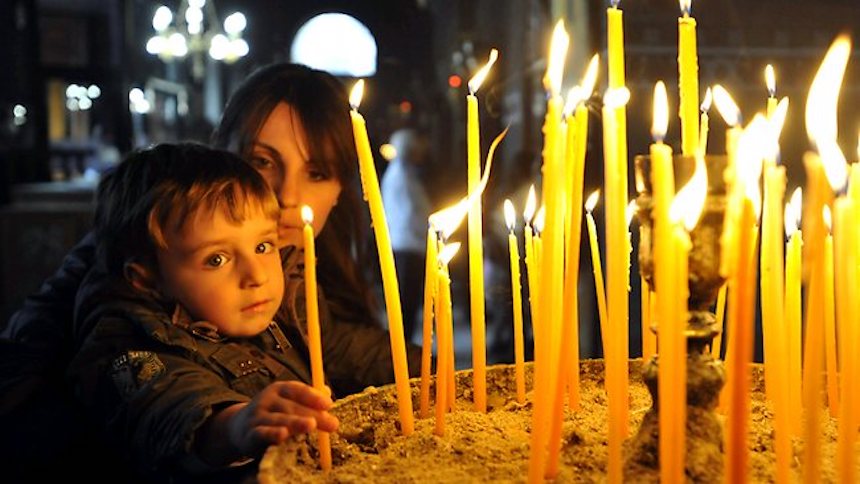
This past week, a friend of mine visited my Byzantine Catholic parish. Afterwards, she admitted that she had been rather apprehensive about how her small child was going to react to the whole experience. After all, she knew that the Byzantine Liturgy was typically ninety minutes long, rather than the forty-five minute Mass which her son had previously been used to experiencing.
Even though I have no children of my own, I offered the somewhat counter-intuitive claim that the Byzantine Liturgy is in some ways better suited to children than a Novus Ordo or Tridentine Mass. A bold claim, I know, but I stand by it! So, here are my top ten reasons why I think the Byzantine Liturgy is great if you have small children…
Reason #1: No long silences
Times of extended silence at church are wonderful. They give you time to calm your mind, find rest your soul and contemplate God. Of course, if you’re a parent, these are also inevitably the times during which your toddler either has a meltdown or loudly announces to the congregation that he’s just done a big poo… Fortunately, in the Byzantine Liturgy there are far fewer moments of silence in which this can happen – our constant singing will cover up a lot!

Reason #2: Rarely a dull moment
Related to the first reason, it’s worth pointing out that there’s rarely a dull moment in the Byzantine Liturgy. It is highly immersive, full of sensory experiences, making it well-suited for children as well as adults. As mentioned above, we are almost always singing. Not only that, the sanctuary is full of colour. The various gates on the icon screen will open and close. We stand. We sit. We bow. We make the sign of the cross. Objects are incensed and anointed. There are processions inside the church by the clergy and altar servers. Sometimes even the entire congregation processes around the exterior of the church! There are icons to kiss and candles to light. It’s not unusual to see parents taking their children to light a candle even during the prayers and nobody bats an eyelid. At the conclusion of the Liturgy, the congregation often receive blessed bread (“Antideron”) and are anointed with oil on their foreheads. So, as Liturgies go, ours is pretty action-packed even if you’re not an altar server, giving the kids lots to see and experience.
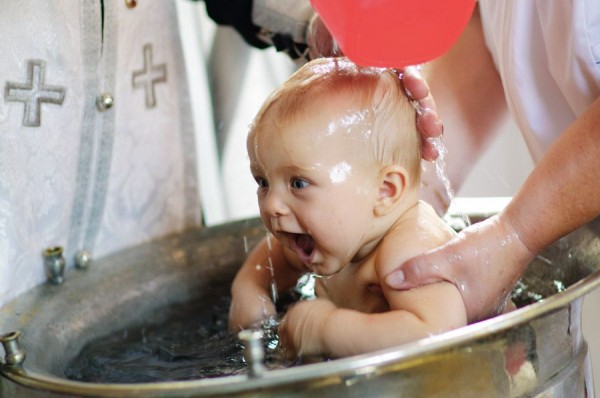
Reason #3: Big families
Just the other day on Twitter, I saw a chap complaining about noisy children on planes. He said,“You decide to have them, you deal with it alone, at home, and don’t travel until they’re capable of it without trouble”. I asked him if he had kids…he said no. I asked him if he’d done any baby sitting…he said no. Unsurprised by these answers, I suggested to him that perhaps he should actually spend some time looking after children before begin quite so ready to criticise parents…
Unfortunately, I’ve even encountered folks with this kind of attitude at Catholic parishes. I’ve known lots of parents who have had parishioners come over and “suggest” that they go to the “cry room” (more on that later). I’ve even known some friends who have been publicly scolded by strangers!
Fortunately, at least at the Byzantine parishes I’ve attended, it’s not unusual to see large families. This means that, if your two-year old is being a bit of a terror, the congregation empathises and is on your side. They know that kids can sometimes be fussy, get restless or misbehave…particularly during the “terrible twos”. It also means that those in the pews around you will be much more likely to pitch in and help if necessary. At both of the Byzantine parishes I’ve attended, it’s not unusual to see kids passed around between parishioners from different families!
Another additional benefit of having large families at parishes is that your kids will most likely find other children of similar age with whom they can play.
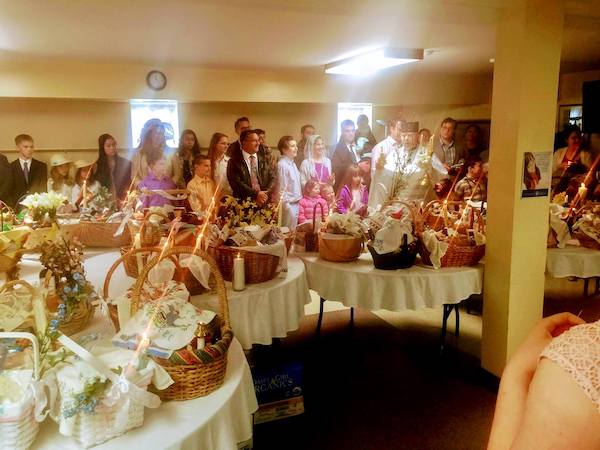
Reason #4: No cry room!
Speaking of the cry room, you won’t find one in a Byzantine Church. There’s no segregation in our churches between the parishioners with small children and those without.
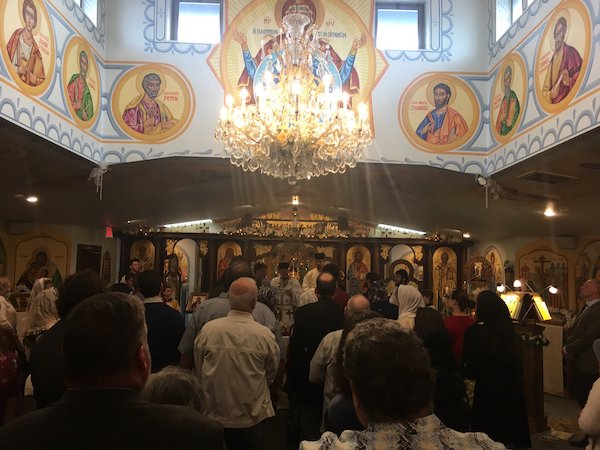
Reason #5: Smaller building
Eastern Rite parishes typically have smaller congregations than most Latin Rite parishes. This means that the church building itself will probably be smaller. This has two advantages:
(a) Since it is smaller, your child will more easily see the action of the Liturgy, reducing (although certainly not excluding!) the likelihood of boredom.
(b) It also means that you’ll be able to quickly scoop up Junior and get out to the Narthex quickly if he starts having a nuclear melt-down!

Reason #6: Married clergy
In the Byzantine Church we have married clergy, which means that your Pastor could well be a biological father, as well as a spiritual one. As a result, he’ll be intimately acquainted with a small child’s ability to create chaos, despite your heroic efforts.

Reason #7: A different kind of Children’s Liturgy
In the Byzantine Church, there are some common conventions which offer really nice moments in the liturgy where children play a unique role. If you visit a Byzantine parish, you may see some of the following:
(a) When it comes time to read the Gospel, all the kids are invited to walk up to the front of the church and gather around the priest as he proclaims the Gospel. Not only will they get to see everything up close, it sends a very clear message that children are important participants in the Liturgy.
(b) As the priest walks down the aisle with the Gospel book and later with the bread and wine, children are encouraged to reach out and touch his vestments as he walks past. It’s rather delightful seeing the kids getting excited as they see their pastor approaching.
(c) On the “Sunday of Orthodoxy”, when we celebrate the reestablishment of icons, children will often process into the church with their icons from home.
(d) During the Easter/Paschal Season, we sing a song about Christ “trampling death by death“. Although I know not everyone likes it, it’s not unusual at this point for all the children to stomp their feet. Personally, I find it rather hard not to grin when this happens.
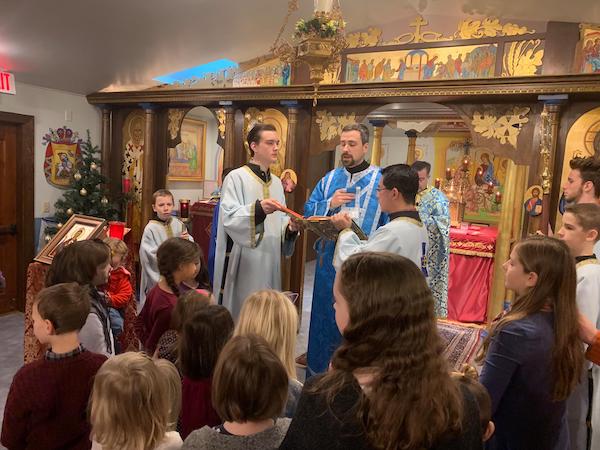
Reason #8: Picture books on the walls
Rather than statues, we like to cover every square inch of our church walls with icons. The church is inadvertently providing you with a picture book for your children! You will often see a parent pick up a fussing kid and walk over to the side of the church and talk to their child about the Saint or Gospel scene depicted on the wall.

Reason #9: Always eating at the family table
The Eastern Rites of the Church retain the more ancient ordering of the Sacraments of Initiation, namely Baptism, Confirmation/Chrismation, and then Eucharist. Not only that, all of these Sacraments are administered at the same time. This means that your child will receive all the Sacraments of Initiation as a baby. By receiving all the sacraments as an infant, it means that your child will begin receiving Jesus in the Eucharist from the first weeks of his or her life.
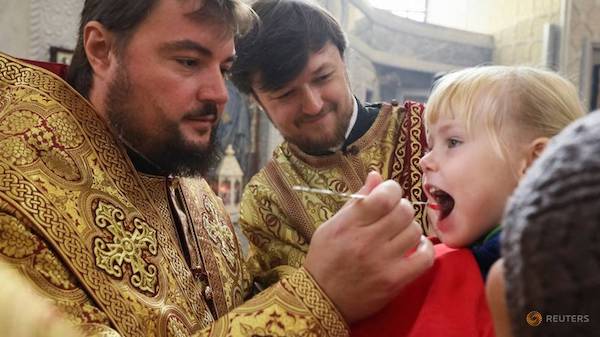
Reason #10: Eastern Catholic Formation
I have been involved with Latin Rite parishes most of my life and have seen how Confirmation is often incorrectly regarded as a kind of Catholic bar mitzvah, a sort of graduation after which the children think that, since they have “got” their Sacraments, they no longer need to go to church. However, because Eastern Rite Catholics receive Confirmation/Chrismation as a baby, this dynamic isn’t present in our parishes. Additionally, at least in the parishes I’ve attended, children receive catechesis right up until the point at which they leave High School, hopefully offering them a more thorough preparation for adult life.
Having said all that, I have to say that I think children receive the majority of their religious formation during the Liturgy itself. I can’t think of a better way to end this post than by quoting something which a Byzantine dad recently wrote to me:
“I’m biased, but I love the experiences and interaction my children get to have through the liturgical services.
A Byzantine Dad
Holy Saturday my two-year-old was telling me how Jesus died and was in the tomb after she went to Good Friday vespers and walked in procession entering the church by stepping under the icon of Christ before He is laid in burial in church. Driving home Thomas Sunday I got to hear reprises of “Christ is Risen” from my three-year-old.
Every Sunday there are about five or six instances where the children get to touch, feel and interact with the liturgy which helps them take interest and focus on the liturgy. I think many of us are also just big kids, and the interaction with the liturgy helps me to personalize not only my Sunday worship experience but also my relationship with my Savior”
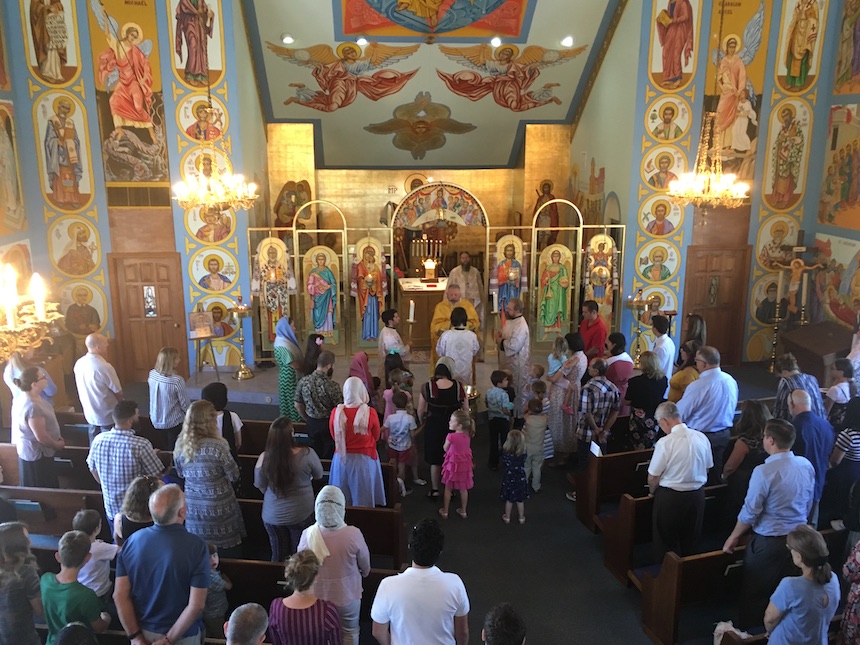
So, if you’ve got young kids and you’re in the area, don’t be afraid to check out your local Byzantine parish!
If anyone reading this goes to a Tridentine or Ordinariate Mass, I’d love it if you’d write a version of this article for that liturgical form!
I came across the following article which offers some suggestions for surviving the long Holy Week services with children:
https://saintpaulemmaus.org/2018/03/30/a-parents-guide-to-surviving-holy-week-a-pep-talk
Pilgrim, as someone with young kids who has attended Orthodox services, but whose regular worship is in the Ordinariate’s use, I can attest to everything that you write. My young boys (7 and under) are enamored with the Byzantine rite. My middle son especially, who is a very sensory-immersion kind of person, gets incomparably more engaged than anything the Latin church has to offer. I wish I could write a puff piece about how the Ordinariate or the TLM are just as good, but that would be an exercise in the textbook definition of sophistry: “making the weaker argument look the stronger.”
Hey Tom, thanks for your reply and welcome to Restless Pilgrim! I do think a case can be made for TLM and the Ordinariate, but I do think they would inevitably be weaker.
I am convert who became Roman Catholic in 2013. In my few years of being Catholic I have seen the worst of the worst novus ordo Masses and the best of the best Tridentine Masses (in terms of reverence). And while I admit, I will always be partial to the sound of Gregorian chant over that of chanting in the vernacular, I must admit there is nothing on God’s green Earth quite like the Divine Liturgy. While I accept that the Mass and the Divine Liturgy are equal in as far as God is present, I have found (in my personal opinion based only on my personal experience) that the Divine Liturgy is the closest we can get to experiencing Heaven on Earth. There is something about the freedom within a Divine Liturgy that, while jarring to my western notions of what Mass “should be”, has become nothing short of intoxicating, now that I have been exposed to it repeatedly. I have two small children and also can affirm everything written in this article. The Divine Liturgy is for children as much as it is for adults. In the Holy Sacrifice of the Mass, children are passive participants. They sit there almost completely in silence, doing nothing (in the TLM) or perhaps responding to a few prayers here and there in the novus ordo (assuming they are old enough to read/follow along). But the Divine Liturgy is not something you participate in privately or in small doses. Done right, the Divine Liturgy is something you live. I can attest Eastern parishes are full of the most loving and wonderful people you can imagine. Our first Divine Liturgy experience was horrifying (I still feel “shame” over it, due to my western notions of how to behave at Mass/in God’s house). Our kids were very noisy and fussy, lots of crying, etc. But our son decided he wanted to run away. He kept running around the pews giggling and every time I ran after him he’d go the other way. Father was giving his homily during this time and was gracious enough not to let it bother him and kept doing his duty. But then our son decided to storm the altar!!!!!!! A member of the parish had to get him and bring him back for me. It interrupted the Liturgy. I was so ashamed and embarrassed. I felt like everyone would be judging me for not being able to control my son. A few people were chuckling, but nobody looked outwardly upset. Father made a friendly joke about him wanting to be a priest (which of course, I pray for anyways), and Liturgy resumed as though nothing had happened. Afterward, everyone made us feel like we were long time members of the parish and helped us fit right in. I think every single Roman Catholic owes it to themselves to attend an Eastern Catholic Church at some point in their life. Once I got a taste of Eastern spirituality and several more Liturgies under my belt, I realized I had begun changing. Western spirituality (for the most part) no longer resonates with me. It’s too orderly and cold/rigid (for lack of better terminology). There is just something about Eastern Christianity that is so…alive! I can’t get enough and I want to give this precious gift of God to my children! Thank you for sharing this article! God Bless anyone and everyone who visits this page!
Hey Colin, thanks for you message and welcome to Restless Pilgrim! There really is nothing quite like The Divine Liturgy!
Pingback: Katechéza pre deti: Na božskej liturgii si pripomíname (43) - Gréckokatolícke katechézy, články